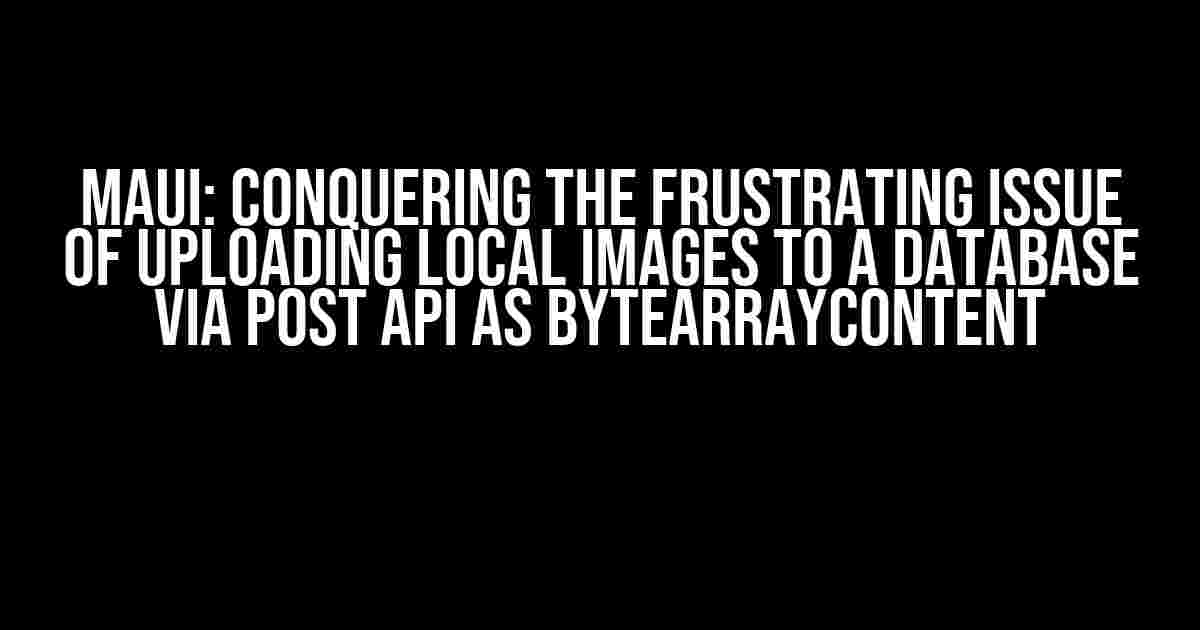Are you tired of encountering the infamous System.ArgumentNullException error when attempting to upload local images to your database via a Post API using ByteArrayContent in your MAUI project? Worry no more, friend! We’ve got you covered. In this comprehensive guide, we’ll delve into the root cause of this issue and provide a step-by-step solution to get you back on track.
Understanding the Problem
Before we dive into the solution, let’s take a closer look at the problem. When you attempt to upload a local image to your database using ByteArrayContent, you might encounter the following error:
System.ArgumentNullException: Value cannot be null. (Parameter 'bytes')This error occurs because the `ByteArrayContent` class expects a non-null array of bytes, but you’re passing a null value. But why is this happening? It’s because the image file is not being properly converted to a byte array.
Step 1: Retrieving the Local Image File
The first step in uploading a local image to your database is to retrieve the image file. In your MAUI project, you can use the `MediaPicker` class to achieve this:
C#:
var picker = new MediaPicker();
var file = await picker.PickPhotoAsync();
Make sure to add the necessary permissions to your AndroidManifest.xml file:
<uses-permission android:name="android.permission.READ_EXTERNAL_STORAGE" />
<uses-permission android:name="android.permission.WRITE_EXTERNAL_STORAGE" />Step 2: Converting the Image File to a Byte Array
Now that you have the local image file, it’s time to convert it to a byte array. You can use the `File.ReadAllBytes` method to achieve this:
C#:
using (var stream = File.OpenRead(file.Path))
{
using (var memoryStream = new MemoryStream())
{
stream.CopyTo(memoryStream);
var fileBytes = memoryStream.ToArray();
// fileBytes is now a byte array representation of the image file
}
}
Step 3: Creating the ByteArrayContent
With the byte array in hand, you can now create the `ByteArrayContent` object:
C#:
var content = new ByteArrayContent(fileBytes);
content.Headers.ContentType = new MediaTypeHeaderValue("image/jpeg"); // or the appropriate MIME type
Step 4: Uploading the Image to the Database via Post API
Finally, you can upload the image to your database using the `HttpClient` class:
C#:
using (var client = new HttpClient())
{
var response = await client.PostAsync("https://your-api-endpoint.com/upload-image", content);
response.EnsureSuccessStatusCode();
}
Troubleshooting Common Issues
While the above solution should work for most cases, you might still encounter some issues. Let’s troubleshoot some common problems:
Image Size Exceeds Maximum Allowed Size
If your image file is too large, you might encounter errors during the upload process. To resolve this, you can resize the image before uploading:
C#:
using (var stream = File.OpenRead(file.Path))
{
using (var memoryStream = new MemoryStream())
{
stream.CopyTo(memoryStream);
var fileBytes = memoryStream.ToArray();
// Resize the image
using (var image = new Image(fileBytes))
{
image ResizeImage(image, 1024, 768); // resize to 1024x768 pixels
fileBytes = image.GetByteArray();
}
}
}
Incorrect MIME Type
Ensure that you’re using the correct MIME type for your image file. You can use the following MIME types:
- image/jpeg
- image/png
- image/gif
- image/bmp
- image/tiff
Verify that the MIME type matches the actual image file type to avoid errors.
Conclusion
In this comprehensive guide, we’ve discussed the frustrating issue of uploading local images to a database via Post API as ByteArrayContent in MAUI projects. By following the step-by-step solution outlined above, you should be able to successfully upload your images to your database.
Remember to troubleshoot common issues, such as image size limitations and incorrect MIME types, to ensure a seamless uploading experience. With this knowledge, you’ll be well on your way to conquering the world of MAUI development!
| Step | Description |
|---|---|
| 1 | Retrieve the local image file using MediaPicker |
| 2 | Convert the image file to a byte array using File.ReadAllBytes and MemoryStream |
| 3 | Create the ByteArrayContent object with the byte array and set the correct MIME type |
| 4 | Upload the image to the database using HttpClient and PostAsync |
Happy coding, and don’t forget to share your experiences and insights in the comments below!
Frequently Asked Question
Having trouble uploading local images to your database via POST API as ByteArrayContent in MAUI? Don’t worry, we’ve got you covered! Here are some frequently asked questions and answers to help you resolve the pesky System.ArgumentNullException issue.
Q1: What is the most common cause of System.ArgumentNullException when uploading images in MAUI?
A1: The most common cause of System.ArgumentNullException is when the file path or the image stream is null. Make sure to check if the file exists and if the stream is properly initialized before attempting to upload the image.
Q2: How can I ensure that the image stream is properly initialized before uploading?
A2: You can use the `OpenReadAsync` method to read the file stream and ensure it’s not null before uploading. For example: `using var stream = await file.OpenReadAsync();`
Q3: What is the correct way to convert the image stream to ByteArrayContent in MAUI?
A3: You can use the `ReadAsArrayAsync` method to read the stream as a byte array, and then create a new `ByteArrayContent` instance with the byte array. For example: `var byteArray = await stream.ReadAsArrayAsync(); var content = new ByteArrayContent(byteArray);`
Q4: How can I troubleshoot the issue further if I’m still getting System.ArgumentNullException?
A4: Try to debug the issue by checking the values of the file path, image stream, and byte array before uploading. You can also use a sniffer tool like Fiddler or Postman to inspect the request and response bodies.
Q5: Are there any other best practices I should follow when uploading images in MAUI?
A5: Yes, make sure to use the `using` statement to dispose of the file stream and byte array correctly. Also, consider compressing the image before uploading to reduce the file size and improve performance.


